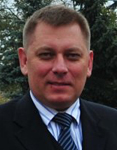Abstract
The article presents an online system for symbolic differentiation. It shows how derivatives are calculated. The trees are used for internal representation of formulas. Derivatives are generated by tree transformations. Presented algorithms are part of the microsystems simulator Dero. They are required by the calculation algorithms such as Newton-Raphson. They can be used to generate derivatives in model description languages and for automatic derivative calculation. DerivWWW can be used in didactics. The system can serve as a tool for students to count function derivatives at the point. It can also be used in teaching on the technical fields of study. Symbolic derivatives are saved in the Tex format, allowing easy integration with other software. The developed and implemented algorithms are discussed. Examples of use are given.References
Stephen E.Senturia, "Simulation and design of microsystems: a 10-year perspective", Sensors and Actuators, A67:1–7, 1998.(in English).
Marc. E. Herniter, "Schematic Capture with MicroSimPSpice". Prentice Hall, Upper Saddle River, NJ, 1998..(in English).
A. R. Newton, J. D. Deutch. "Data-flow based behavioral-level simulation and synthesis". Proc. IEEE ICCAD, Sept 1983..(in English).
J. Ogrodzki, "Circuit simulation methods and algorithms". CRC Press, Boca Raton, Florida,USA, 1994..(in English).
J. Ogrodzki, "Computer analysis of electronic circuitsPWN", Warsaw, 1995.(in Polish).
D. Bukat, J. Ogrodzki, "Compact modelling in circuit simulation: the general purpose analyzer OPTIMA 3". ISCAS 94 PROCEEDINGS, pages 383–386, 1994.(in English).
Leon O. Chua Pen-Min Lin, ""Computer analysis of electronic circuits.WNT, Warsaw, 1981.(in Polish).
Tom Niemann. Lex &Yacc Tutorial. WWW page. http://epaperpress.com/lexandyacc/.(in English).
IEEE Standard VHDL (Integrated with VHDL-AMS changes). Institute of Electrical and Electronics Engineers, 345 East 47th Street, New York, NY 10017, USA, 1 Aug 1998.(in English).
PHP. PHP developers WWW page. http://www.php.net/docs.php.(in English).
Paweł Plaskura. ""Deriv www page" . WWW project page. http://deriv.aiva.pl.(in English).
Paweł Plaskura, "Dero v4 microsystems simulator". s. AIVA, 2013. ISBN: 978-83-937245-1-2.(in Polish).
Paweł Plaskura, ""Advanced methods of electronic simulation". Computational methods and algorithms. AIVA, 2013. ISBN: 978-83-937245-0-5.(in Polish).
J. Ogrodzki, P. Plaskura,, "OPTIMA v4 User Manual. Institute of Electronic Systems", Warsaw University of Technology, Warsaw, 1999.(in English).
A. Richard Newton, "Resve Saleh, Shyh-JyeJou. Mixed-mode simulation and analog multilevel simulation". Kluwer Academic Publishers", Norwell, Massachusetts 02061,USA, 1994.(in English).
Bruce Schneier, "Cryptography for Practitioners: Protocols", Algorithms, and Source Programs in C.WNT, Warsaw, 2002.(in Polish).
Deepak Kumar Tala, "Verilog Tutorial". WWW page. http://www.asic-world.com/verilog/veritut.html.(in English).
D. C. van Duyn. "Modelling and simulation of solid-state transducers: the thermal and electrical energy domain" . Sensors and Actuators, A41:268–274, Jan 1994.(in English).
Niklaus Wirth, "Algorithms + Data Structures = Programs.WNT", Warsaw, 2004(in Polish).
Authors who publish in this journal agree to the following terms:
- Authors hold copyright immediately after publication of their works and retain publishing rights without any restrictions.
- The copyright commencement date complies the publication date of the issue, where the article is included in.
Content Licensing
- Authors grant the journal a right of the first publication of the work under a Creative Commons Attribution-NonCommercial-ShareAlike 4.0 International License (CC BY-NC-SA 4.0) that allows others freely to read, download, copy and print submissions, search content and link to published articles, disseminate their full text and use them for any legitimate non-commercial purposes (i.e. educational or scientific) with the mandatory reference to the article’s authors and initial publication in this journal.
- Original published articles cannot be used by users (exept authors) for commercial purposes or distributed by third-party intermediary organizations for a fee.
Deposit Policy
- Authors are permitted and encouraged to post their work online (e.g., in institutional repositories or on their website) during the editorial process, as it can lead to productive exchanges, as well as earlier and greater citation of published work (see this journal’s registered deposit policy at Sherpa/Romeo directory).
- Authors are able to enter into separate, additional contractual arrangements for the non-exclusive distribution of the journal's published version of the work (e.g., post it to an institutional repository or publish it in a book), with an acknowledgement of its initial publication in this journal.
- Post-print (post-refereeing manuscript version) and publisher's PDF-version self-archiving is allowed.
- Archiving the pre-print (pre-refereeing manuscript version) not allowed.


